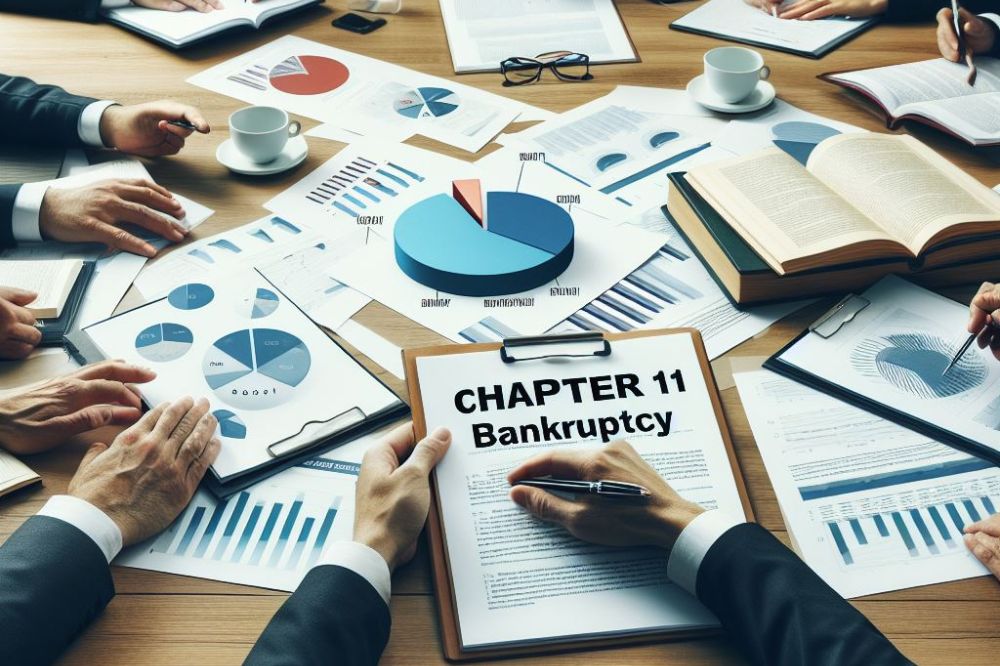Navigating the complexities of Chapter 11 bankruptcy for businesses can be daunting. However, understanding the bankruptcy procedure is crucial for companies facing financial turmoil and debtors. This form of bankruptcy allows struggling businesses, debtors, to reorganize and potentially emerge stronger, benefiting from the benefits, contrasting with liquidation under Chapter 7. By utilizing Chapter 11 bankruptcy procedure, debtors can continue operations while developing a plan to repay creditors and restructure debts. It offers a lifeline for companies seeking help to stay afloat amidst financial challenges and time, providing an opportunity for recovery in business affairs and revitalization in a competitive market landscape.
Key Takeaways
- Understanding Chapter 11:
- Chapter 11 bankruptcy provides businesses with a chance to reorganize and continue operations.
- Seek professional guidance to navigate the complex process effectively.
- Utilizing the Automatic Stay:
- The automatic stay halts creditor actions, giving businesses breathing room to restructure debts.
- Use this period wisely to develop a sustainable financial plan.
- Crafting a Plan of Reorganization:
- Develop a detailed plan outlining how the business will repay debts and operate profitably in the future.
- Ensure the plan is feasible and acceptable to creditors for a successful restructuring.
- Engaging in Legal Proceedings:
- Be prepared for legal proceedings involved in Chapter 11, such as court hearings and negotiations.
- Stay informed and actively participate in the process to protect the business’s interests.
- Involvement of Committees and Trustees:
- Committees and trustees play crucial roles in overseeing the bankruptcy process.
- Collaborate with these entities to enhance transparency and maximize chances of a successful outcome.
- Exiting Chapter 11 Successfully:
- Focus on meeting the requirements of the reorganization plan to successfully exit Chapter 11.
- Comply with post-bankruptcy obligations to ensure a smooth transition back to regular business operations.
Understanding Chapter 11
Bankruptcy Basics
Chapter 11 bankruptcy is a reorganization process for businesses to restructure debts and operations. It allows companies to continue operating while developing a plan to repay creditors. The primary goal of Chapter 11 is to enable struggling businesses to become profitable again.
Key differences between Chapter 7 and Chapter 11 lie in their objectives and outcomes. Chapter 7 involves liquidation, where assets are sold to pay off debts, leading to business closure. In contrast, Chapter 11 focuses on restructuring debt to keep the business operational.
How It Works
Filing for Chapter 11 involves submitting a petition with the bankruptcy court. The debtor in possession retains control of day-to-day operations during the process. Reorganization plans are crucial in outlining how the company will restructure its debts, operations, and finances.
The debtor in possession plays a significant role in managing the business throughout the bankruptcy proceedings. They oversee business operations, negotiate with creditors, and develop reorganization plans to present to creditors for approval. This individual or entity must act in the best interests of both the company and its creditors.
Key Players
Debtor in Possession
Responsibilities of the debtor in possession include managing business operations, negotiating contracts, and making financial decisions. They have the authority to propose reorganization plans without immediate creditor approval but are subject to court oversight. Limitations exist on major decisions, requiring court approval.
The U.S. Trustee oversees Chapter 11 cases by appointing committees, monitoring compliance with laws, and ensuring transparency in financial reporting. Their responsibilities involve reviewing financial information, conducting meetings with stakeholders, and overseeing creditor distributions based on approved plans.
Creditors’ Committees
Creditors’ committees represent various creditor interests by participating in negotiations and advocating for fair treatment. They help ensure that creditor rights are protected during the bankruptcy process by providing input on reorganization plans and challenging actions that may harm creditors’ interests.
Filing Requirements
Necessary documents for filing Chapter 11 include financial statements, schedules of assets and liabilities, income/expense reports, and a list of executory contracts/agreements. Deadlines for filing vary depending on circumstances but adherence is crucial to avoid dismissal. Fees associated with filing cover court costs and administrative expenses incurred during the process.
Types of Chapter 11 Debtors
Small Business Cases
A small business case in Chapter 11 involves businesses with debts below a certain threshold, typically around $2.7 million. These cases benefit from streamlined procedures, such as simplified reporting requirements and a faster reorganization process.
Filing as a small business offers advantages like increased control over the restructuring process and the ability to propose a plan without creditor approval. Small businesses can save on legal costs due to the expedited nature of these cases.
Single Asset Real Estate
Single asset real estate refers to properties that generate income and have no substantial business operations. In Chapter 11, these cases are subject to specific rules requiring debtors to file a plan within strict timelines and make payments promptly.
Challenges in single asset real estate cases include the pressure to quickly reorganize or sell the property. However, benefits include the potential for debt reduction and the ability to negotiate with creditors effectively.
Equity Security Holders
Equity security holders are individuals or entities holding stock or ownership interests in a business under Chapter 11 protection. They have rights to participate in creditor meetings, vote on reorganization plans, and receive information about the case’s progress.
Equity security holders play a crucial role in the reorganization process by influencing decisions through voting on proposed plans. Their business interests align with maximizing the value of their investments while ensuring the company’s sustainable future.
The Automatic Stay Explained
Purpose and Impact
Chapter 11 bankruptcy aims to help businesses restructure their debts and continue operations. The primary goals include allowing the debtor to propose a plan to repay creditors over time. This process enables the business to remain operational while addressing financial difficulties.
The impact of Chapter 11 on businesses is significant, providing them with a chance to reorganize and stay afloat. By halting creditor collection efforts, it offers breathing room for companies to negotiate new terms with creditors. This can lead to reduced debt burdens and improved cash flow.
Successful Chapter 11 reorganization can have several positive outcomes for businesses and stakeholders. One key benefit is the ability to renegotiate contracts and leases, helping the business become more financially stable. It allows for the possibility of selling business assets or divisions that are no longer profitable.
Exceptions
In some cases, certain types of business debtors may not be eligible for Chapter 11 bankruptcy protection. For example, individuals who do not meet specific criteria or small businesses might face challenges in filing under Chapter 11. Businesses that lack a feasible plan for restructuring their debts may not succeed in the process.
While Chapter 11 offers many advantages, there are also potential downsides to consider. One drawback is the high costs associated with legal fees and administrative expenses during the bankruptcy proceedings. Moreover, the process can be complex and time-consuming, requiring substantial effort from both management and stakeholders.
Financial Operations
Cash Collateral Use
Businesses undergoing chapter 11 bankruptcy can utilize cash collateral to fund their operations during the restructuring process. This allows them to access necessary funds without seeking additional approval. By using cash collateral, companies can continue their day-to-day operations and maintain essential services for customers and employees. It provides a lifeline for businesses facing financial difficulties, ensuring they can navigate through the challenges of bankruptcy.
Adequate Protection
During chapter 11 bankruptcy, creditors providing loans or other forms of financing are entitled to receive adequate protection. This ensures that their interests are safeguarded while the business reorganizes its financial situation. Adequate protection can come in various forms, such as replacement liens or periodic cash payments, aimed at compensating creditors for any decrease in the value of their collateral. By providing this protection, businesses can maintain creditor confidence and support throughout the bankruptcy process.
Operating Capital Management
Effective business operations management is crucial for maintaining sufficient operating capital during chapter 11 bankruptcy. Companies must carefully monitor their financial situation and make strategic decisions to optimize cash flow and reduce expenses. By efficiently managing operations, businesses can maximize their resources and improve their overall financial stability. This includes negotiating with vendors, reassessing inventory levels, and implementing cost-cutting measures to ensure long-term viability post-bankruptcy.
Plan of Reorganization
Filing a Plan
Businesses undergoing chapter 11 bankruptcy must file a detailed reorganization plan with the court. This plan outlines how the company intends to restructure its debts and operations. The filing typically includes proposed changes to debt terms, treatment of creditors, and strategies for becoming profitable again.
When submitting the reorganization plan, businesses need to ensure it complies with legal requirements. This involves providing accurate financial information, outlining how debts will be repaid, and detailing how the company plans to operate post-bankruptcy. The court then reviews the plan to determine its feasibility and fairness to creditors.

Avoidable Transfers
During chapter 11 bankruptcy, businesses must address any avoidable transfers made before filing for bankruptcy. These transfers involve moving assets or money out of the business that could have been used to repay creditors. To rectify this, the court may require these transfers to be reversed or compensated for in the reorganization plan.
By identifying and addressing avoidable transfers, businesses can demonstrate transparency and fairness in their bankruptcy proceedings. This process helps ensure that all creditors are treated equitably and that assets are appropriately allocated for debt repayment.
Disclosure Statement
As part of the chapter 11 bankruptcy process, businesses are required to prepare a disclosure statement. This document provides detailed information about the company’s financial situation, proposed reorganization plan, and future prospects. Creditors use this statement to evaluate the feasibility of the plan and make informed decisions regarding its acceptance.
The disclosure statement aims to provide transparency and clarity regarding the business’s intentions post-bankruptcy. By offering comprehensive information, businesses can enhance creditor trust and increase the likelihood of plan acceptance.
Plan Acceptance
Once the reorganization plan is filed and reviewed by creditors, it undergoes a voting process for plan acceptance. Creditors have the opportunity to vote on whether they approve or reject the proposed plan. For the plan to be accepted, it must receive approval from creditors holding a certain percentage of claims.
Plan acceptance is crucial for businesses seeking to emerge successfully from chapter 11 bankruptcy. Achieving creditor support is essential for implementing the restructuring efforts outlined in the plan and moving towards financial stability.
Legal Proceedings in Chapter 11
Motions and Orders
Motions are formal requests made to the court for various purposes, such as seeking approval for actions. Orders are directives issued by the court in response to motions, outlining specific actions or decisions. These legal processes play a crucial role in guiding the restructuring process within Chapter 11 bankruptcy.
In Chapter 11 bankruptcy, businesses often file motions to seek approval for essential actions, like using cash collateral or entering into contracts. Orders issued by the court provide clarity and legal backing for these motions, ensuring compliance with bankruptcy laws and regulations. The interaction between motions and orders is fundamental to navigating the complexities of Chapter 11 proceedings effectively.
Adversary Proceedings
Adversary proceedings are separate lawsuits initiated within the bankruptcy case to resolve specific disputes or issues. These proceedings involve litigation between parties and can address matters like fraudulent transfers or objections to discharge debts. Adversary proceedings add a layer of complexity to Chapter 11 cases but are essential for resolving contentious matters through legal channels.
In some instances, creditors may file adversary proceedings against debtors to challenge certain aspects of the bankruptcy process. These proceedings require careful evaluation and legal representation to protect the interests of all parties involved. Understanding adversary proceedings is critical for businesses undergoing Chapter 11 bankruptcy to navigate potential legal challenges effectively.
Claims Management
Claims management involves handling creditor claims against the business during the Chapter 11 process. Creditors submit claims detailing the debts owed to them, which are then reviewed and categorized based on priority. Effective management of claims ensures equitable treatment of creditors and facilitates the distribution of assets according to the approved reorganization plan.
Businesses in Chapter 11 must establish robust systems for processing and verifying creditor claims accurately. This includes addressing any disputed claims through negotiations or mediation, ultimately leading to a resolution that aligns with the overall restructuring goals. Prioritizing efficient claims management is essential for successfully restructuring debts and emerging from Chapter 11 bankruptcy stronger.

The Role of Committees and Trustees
Creditors’ Committees Functions
Creditors’ committees represent the interests of creditors in a bankruptcy case, ensuring fair treatment. They review the debtor’s operations and financial affairs to protect creditors’ rights. They negotiate with the debtor to maximize the recovery for all creditors involved.
These committees play a crucial role in overseeing the bankruptcy process, providing valuable insights into the debtor’s financial situation. By actively participating in negotiations and decisions, they aim to achieve the best possible outcome for all parties involved.
Case Trustee Appointment
A case trustee is appointed by the United States Trustee’s Office to oversee Chapter 11 bankruptcy cases. They are responsible for monitoring the debtor’s compliance with court orders and bankruptcy laws. The trustee also plays a key role in facilitating communication between the debtor and creditors.
The trustee ensures that the bankruptcy process proceeds smoothly by reviewing financial reports, investigating potential misconduct, and ensuring that assets are properly managed. Their appointment brings an impartial perspective to the proceedings, instilling confidence in stakeholders.
Examiner’s Role
In some complex Chapter 11 cases, an examiner may be appointed to investigate specific issues raised during the proceedings. The examiner conducts a thorough review of the debtor’s operations and financial records to provide an unbiased assessment.
Exiting Chapter 11
Plan Confirmation
After proposing a reorganization plan, creditors vote on its approval, leading to confirmation by the court. The plan outlines debt repayment, asset liquidation, and operational changes.
Discharge and Final Decree
Upon fulfilling the obligations outlined in the confirmed plan, businesses receive a discharge. This signifies the completion of the bankruptcy process. A final decree officially closes the case.
Postconfirmation Modification
Businesses may seek modifications to the confirmed plan due to unforeseen circumstances. These modifications require court approval and typically involve financial adjustments or operational changes.
Revocation of Order
If a business fails to adhere to the terms of the confirmed plan, creditors can petition for revocation. This can lead to reinstatement of pre-bankruptcy claims and potentially restarting the bankruptcy process.
Post-Chapter 11 Administration
Postconfirmation Administration
After successfully exiting Chapter 11, businesses enter the postconfirmation phase. This period involves implementing the reorganization plan approved by the court. Financial reporting and compliance become crucial during this stage to ensure adherence to the plan’s terms. Regular monitoring of financial performance is essential to track progress effectively.
During postconfirmation administration, companies must focus on rebuilding relationships with creditors and stakeholders. Maintaining open communication channels is vital for addressing any concerns promptly. Timely payments to creditors as per the reorganization plan demonstrate commitment and reliability, fostering trust among stakeholders.
Conversion or Dismissal Options
In some cases, businesses may face challenges during Chapter 11 that lead to considering conversion or dismissal options. Conversion involves changing the bankruptcy chapter, such as transitioning to Chapter 7 liquidation if reorganization efforts fail. Dismissal occurs when a business’s financial situation improves significantly, warranting termination of the bankruptcy proceedings.
Businesses opting for conversion must assess the feasibility of restructuring under a different chapter. This decision requires careful evaluation of financial implications and potential outcomes. Conversely, dismissal signifies a positive turnaround for the company, indicating successful recovery from financial distress.
- Pros of Conversion:
- Opportunity for a fresh start under a different bankruptcy chapter.
- Potential for more favorable terms based on the new restructuring approach.
- Cons of Conversion:
- Additional legal processes and complexities may arise.
- Uncertainty regarding the success of restructuring efforts under a different chapter.
In contrast, businesses choosing dismissal benefit from avoiding further bankruptcy-related costs and restrictions. The company can resume normal operations without ongoing court supervision. However, it is essential to maintain financial stability post-dismissal to prevent relapse into financial difficulties.
Final Remarks
You’ve now journeyed through the intricate landscape of Chapter 11 bankruptcy for businesses. Understanding its nuances, from the automatic stay to the post-Chapter 11 administration, equips you with the knowledge to navigate these turbulent waters. As you grasp the pivotal role of committees, trustees, and legal proceedings within this realm, you’re better prepared to steer your business towards a successful reorganization.
Take charge of your financial future by implementing these insights into your business strategy. Seek professional guidance when needed, and remember that Chapter 11 is not just a legal process but an opportunity for revitalization. By proactively engaging with the complexities of Chapter 11, you can pave the way for a stronger, more resilient business model. Your dedication to understanding and applying these principles will set you on a path towards sustainable growth and financial stability.
Frequently Asked Questions
What is Chapter 11 bankruptcy and how does it benefit businesses?
Chapter 11 bankruptcy allows businesses to reorganize their debts while continuing operations. It provides protection from creditors, time to develop a repayment plan, and a chance for long-term financial stability.
How does the Automatic Stay work in Chapter 11 bankruptcy?
The Automatic Stay halts all collection actions against the business, providing breathing room to assess finances and create a reorganization plan. It prevents creditors from pursuing lawsuits, foreclosures, or repossessions during the process.
What are the key components of a Plan of Reorganization in Chapter 11?
A Plan of Reorganization outlines how the business will repay its debts, often including renegotiated terms with creditors. It must be approved by creditors and the court, detailing how the company will operate moving forward to achieve financial stability.
Why are Committees and Trustees important in Chapter 11 bankruptcy proceedings?
Committees represent various stakeholders like creditors or shareholders, ensuring their interests are considered during the restructuring process. Trustees oversee the implementation of the reorganization plan, safeguarding assets and ensuring compliance with legal requirements.
What happens after a business successfully exits Chapter 11 bankruptcy?
After exiting Chapter 11, the business continues operating under the approved reorganization plan. It must adhere to new payment schedules, financial reporting requirements, and any other conditions set forth during the bankruptcy process.




